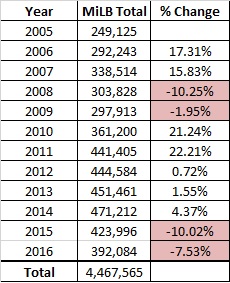First, a look at the Blue Jays average annual and per game attendance from 2007-2016. From 2007-2016, the Blue Jays average annual attendance was 45,578. The Blue Jays per game average in the 656 games at Florida Auto Exchange Stadium from 2007 to 2016 was 730.
Click here for Dunedin Blue Jays season average attendance 2007-2016 charts and analysis.
Next, we will look at Blue Jays average attendance by month from 2007 to 2016. The following graph depicts the Blue Jays average attendance per month.
The following chart depicts their best and worst average attended months.
This chart shows the annual attendance ranking by month each year spanning from 2007 to 2016 as well as the month’s average finish.
(Yellow highlights = Best month/ Red highlights = Worst month)
The next few charts depict average attendance per month per year from 2007 to 2016.
April average per game attendance 2007 to 2016:
May average per game attendance 2007 to 2016:
June average per game attendance 2007 to 2016:
July average per game attendance 2007 to 2016:
August/September average per game attendance 2007 to 2016:
Percentage Changes Since 2007:
- April: up 32%
- May: up 18.5%
- June: up 1%
- July: up 37%
- August/Sept: down 35%
Analysis:
Overall, Dunedin Blue Jays per game attendance has increased 6% per game since 2007 - from 721 per game to 770 per game in 2016. Most of this increase was due to increases in April and July attendance. This increase is similar to monthly increases in Clearwater Threshers attendance, which is only 10 minutes away from Dunedin.
The biggest difference between the two teams is the Blue Jays have seen a steep drop in Aug/Sept attendance since 2007. In the Threshers post, I stipulated that weather could be the reason attendance has increased in April and May. Better promotions could also be a factor.
July attendance is heavily influenced by 4th of July attendance. The Blue Jays fireworks celebration is typically their most attended game of the year. Since 2012, the Jays have drawn over 4,000 fans per Independence Day fireworks promotion (usually either July 4th or the closest home game to the date). In 2011, the Jays only drew 2,000 to their fireworks event, and in 2010 and earlier, there was no fireworks promotion.
Looking at the by-month chart, the August/September decline began in 2008, the same year the Rays made the World Series. After also declining in 2009, Blue Jays attendance in August/September has only slightly recovered.
The Blue Jays are the lowest drawing Minor League team in the Tampa Bay area. Looking at when people attend their games show us quite a bit about the patterns of baseball attendance in Dunedin and Tampa Bay as a whole.









































